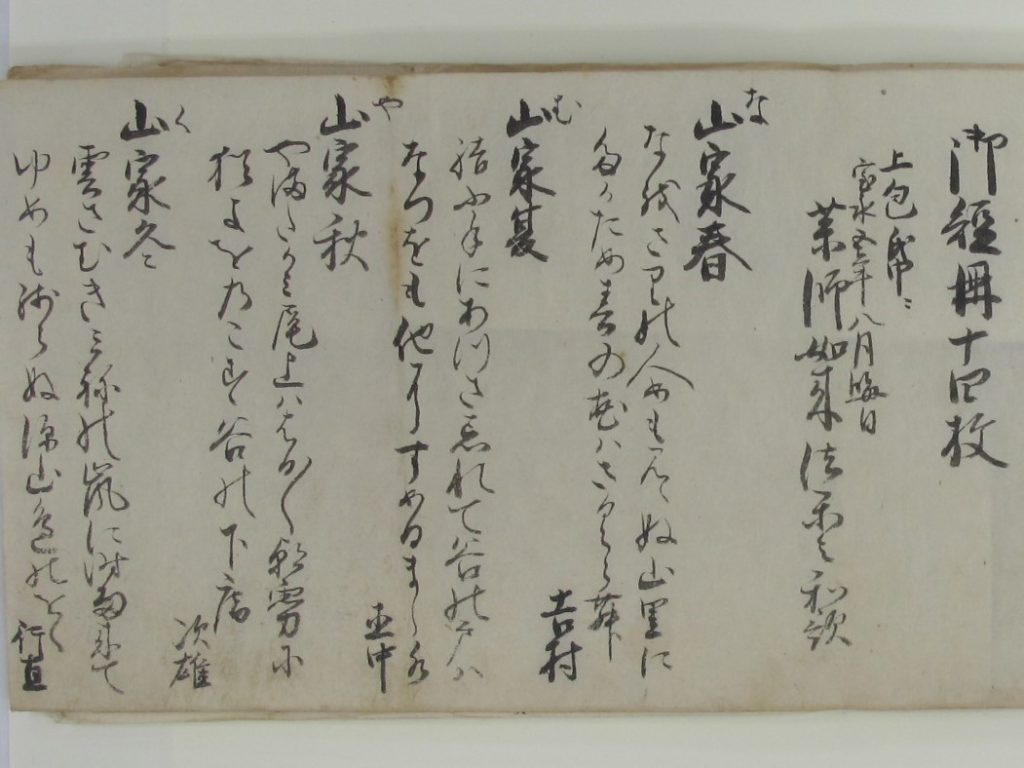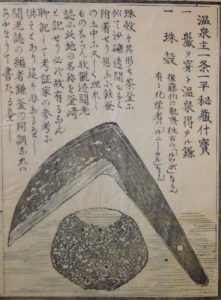How were hot springs managed during the Edo period? The history of the Kamasaki Hot Springs and the Ichijo family
Hot springs during the Edo period
Classical documents written by samurai, farmers, and merchants can be useful when investigating the Edo period. At the time, like today, the world was filled with a variety of jobs and society was built on different occupations. Our research division is currently examining the “Ichijo family document,” a historical source about the management of a hot spring area and inn from the Edo period. From the contents we have discovered, we present “The history of hot springs,” set in Kamasaki Hot Springs in the city of Shiroishi in Miyagi Prefecture.
A tanka poem by Yoshimura Date, fifth lord of the Sendai domain (an Ichijo family document)
In 1708, Yoshimura Date dedicated a tanka poem to the Yakushidō at Kamasaki Hot Springs.
Kamasaki Hot Springs
The Kamasaki Hot Springs are located in southern Miyagi Prefecture surrounded by lush, green mountains; the environment is quiet and refined. The usual explanation about this area is: “The Kamasaki Hot Springs are said to have been discovered over 600 years ago, at the point [saki] of a villager’s sickle [kama]. They are believed to have medicinal properties in the Tohoku region. These renowned hot springs which were even visited by the lord of the Sendai domain attracted a high level of activity in the 19th century. (Quoted from “Yajiro and Kamasaki Hot Springs,” Commerce & Tourism Division, Shiroishi City Hall website).
Discovery of the hot springs
The history of these hot springs supposedly began in 1428. According to a document written about 200 years ago, a woodcutter from the town of Shiroishi (today, it is a city about ten minutes’ drive away) came to gather grass to fertilize his fields and heard the sound of bubbling water from the mountains. Upon approaching the source of the sound, he saw steam; he split a stone with his sickle and struck a hot spring. Since the woodcutter found the hot springs with kama no saki (the end of a sickle), the springs were called “Kamasaki Hot Springs.” The woodcutter built a hot spring resort and moved there, but the hot springs likely suffered severe damage during the heavy flooding of 1455, and the resort had to close.
Revival by Ichijo Ichibee
Over 100 years later in 1573, Ichijo Ichibee, who was visiting Shiroishi from Kyoto, heard that “there is a hot spring nearby” and decided to visit Kamasaki Hot Springs. Ichibee was highly impressed after entering the hot springs, declaring, “The waters are the same as the Arima hot springs [now in Kobe, Hyogo Prefecture].” He thought his name would be remembered for future generations if he could make the springs popular. However, he could not run this business on his own, so he sought the opinions of the locals. They agreed to make Ichibee the yunushi (owner of the hot springs) and revived the Kamasaki Hot Springs, which had lain dormant for years. Ichibee used his own funds to start developing a resort and building accommodations. Gradually, guests from distant lands also came, increasing the high regard in which the hot springs were held.
“The historic sickle”
A picture of the sickle that the woodcutter who discovered Kamasaki Hot Springs supposedly used
The job of a yumori
In each generation since Ichibee’s time, the head of the Ichijo family has operated the Kamasaki Hot Springs. During the Edo period, the Sendai domain granted them the title of yumori (master of the hot springs). Yumori refers to the manager of a hot spring; they were permitted to operate hot springs and inns, and to receive entry fees (yusen) from guests. Of course, part of this income was remitted to the domain in taxes. We tend to imagine that the operator (Ichijo Ichibee and his descendants) owned Kamasaki Hot Springs, but formally, the Sendai domain owned it, although it was actually the Ichijo family’s property.
An important resource
The Kamasaki Hot Springs were under the control of the Sendai domain, along with other renowned hot springs such as Tōgatta, Aone, Akiu, and Naruko. At the time, the office that managed hot springs in the Sendai domain was called the Kanayama-kata. As the name suggests, Kanayama (lit. “metal mountain”) controlled the mining of gold, silver, and copper, as well as the hot springs. Ores have a great impact on finances, but we can see that the hot springs were also treated as a precious resource.
Hot springs and health
Hot springs inspire ideas of leisure and resting, but the people of the Edo period prayed to restore their health in hot springs, with the aim of finding cures for ailments and injuries. The guidebook Ryokō yōjinshū (Collection of travel hints), published in 1810, introduces Kamasaki among the well-known hot springs of Japan, and describes the site as being “most effective for bruises and cuts.” In addition, the springs were believed to prevent afflictions like palsy, beriberi, and lumbago. The social status of the hot springs may have changed over time. (Kenichiro Aratake)


